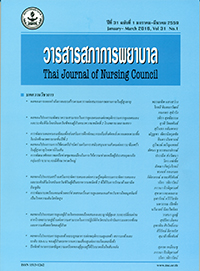ผลของโปรแกรมการดูแลเท้าแบบบูรณาการต่อพฤติกรรมดูแลเท้า สภาวะเท้า และระดับ HbA1c ของผู้ป่วยเบาหวานความเสี่ยงสูงต่อการเกิดแผลที่เท้า
Keywords:
โปรแกรมการดูแลเท้าแบบบูรณาการ, พฤติกรรมดูแลเท้า, สภาวะเท้า, ระดับ HbA1c, ผู้ป่วยเบาหวานความเสี่ยงสูงต่อการเกิดแผลที่เท้า, integrative podiatric care programme, foot-care behaviour, foot conditions, HbA1c level, diabetes patients, high susceptibility to foot woundAbstract
บทคัดย่อ: วัตถุประสงค์ของการวิจัย: เพื่อศึกษาผลโปรแกรมการดูแลเท้าแบบบูรณาการ ต่อพฤติกรรมดูแลเท้า สภาวะเท้า และระดับ HbA1c ในผู้ป่วยเบาหวานความเสี่ยงสูงต่อการ เกิดแผลที่เท้า
การออกแบบวิจัย: การวิจัยแบบกึ่งทดลองเปรียบเทียบ 2 กลุ่ม
การดำเนินการวิจัย: กลุ่มตัวอย่างเป็นผู้ป่วยเบาหวานความเสี่ยงสูงต่อการเกิดแผล ที่เท้าจำนวน 60 คน ในคลินิกเบาหวาน โรงพยาบาลบางละมุง จังหวัดชลบุรี แบ่งเป็นกลุ่ม ทดลอง 30 คน และกลุ่มควบคุม 30 คน กลุ่มควบคุม ได้รับการดูแลในระบบบริการปกติ ส่วนกลุ่มทดลองได้รับโปรแกรมดูแลเท้าแบบบูรณาการด้วยการส่งเสริมสมรรถนะแห่ง ตนต่อพฤติกรรมดูแลเท้าร่วมกับการออกกำลังกายบนเก้าอี้เป็นกิจกรรมกลุ่ม 2 ครั้งและ โทรศัพท์ติดตาม 2 ครั้ง รวมระยะเวลา 4 เดือน เก็บรวบรวมข้อมูลโดยใช้แบบสอบถามข้อมูล ส่วนบุคคล ประวัติการเกิดแผลที่เท้า ระดับ HbA1c แบบสัมภาษณ์พฤติกรรมดูแลเท้า และ แบบบันทึกสภาวะเท้า วิเคราะห์ข้อมูลโดยใช้สถิติพรรณนาและสถิติทีคู่และสถิติทีอิสระ
ผลการวิจัย: พบว่าในกลุ่มทดลองมีคะแนนเฉลี่ยพฤติกรรมดูแลเท้าสูงขึ้นและระดับ HbA1c ลดลง ภายหลังได้รับโปรแกรมการดูแลเท้าแบบบูรณาการอย่างมีนัยสำคัญทางสถิติ (p<.001) และเมื่อเปรียบเทียบกับกลุ่มปกติพบว่ามีพฤติกรรมการดูแลเท้าสูงกว่าและมีระดับ HbA1c ต่ำกว่ากลุ่มควบคุมอย่างมีนัยสำคัญทางสถิติ (p<.001)
ข้อเสนอแนะ: ผู้ป่วยเบาหวานความเสี่ยงสูงต่อการเกิดแผลที่เท้าควรได้รับการดูแล อย่างบูรณาการเพื่อส่งเสริมพฤติกรรมดูเท้าร่วมกับการควบคุมระดับน้ำตาลในเลือด
Abstract: Objective: To examine the impact of an integrative podiatric care programme
on the foot-care behaviour, foot conditions and HbA1c level in diabetes patients with
high foot wound risk.
Design: Two-group experimental research with a pre-test and a post-test.
Implementation: This study was conducted on a sample of 60 diabetes patients who
had been identified as highly susceptible to foot wounds and were being treated at the
Diabetes Clinic of Banglamung Hospital, Chonburi province. The subjects were equally
divided into a control group and an experimental group. Whilst the control group received
standard treatment, the experimental group participated in a 4-month integrative podiatric
care programme. Designed for self-empowerment, the programme combined foot-care
practices with on-chair exercise activities. During the programme period, the combined
task was performed twice, with 2 follow-ups by telephone. Data on each subject were
collected by means of (1) a personal information form; (2) a foot wound record; (3)
the HbA1c level; (4) a foot-care behaviour interview form; and (5) a foot condition
recording form. The data were analysed using descriptive statistics, paired t-test, and
independent t-test.
Results: After participating in the integrative podiatric care programme, the
experimental group displayed a significantly increased average foot-care behaviour score
(p < .001). Besides, compared with the control group, the experimental group had
a significantly highly score on foot-care behaviour and a significantly lower HbA1c
level, both by p < .001.
Recommendations: It is suggested that diabetes patients susceptible to foot wounds
be treated with the integrative podiatric care programme, which simultaneously promotes
foot-care behaviour and blood sugar control.
Downloads
References
Dinh T, Tecilazich F, Kafanas A, Doupis J, Gnardellis
C, Leal E, et al. Mechanisms involved in the development
and healing of diabetic foot ulceration. Diabetes
;61:2937-47.
Boulton AJ, Armstrong DG, Albert SF, Frykberg RG,
Hellman R, Kirkman MS, et al. Comprehensive foot
examination and risk assessment. A report of the task
force of the foot care interest group of the American
Diabetes Association of Clinical Endocrinologists.
Diabetes care2008;31(8):1679-84.
Namvongprom A & Pakdevong N. Foot ulcers and
factors relating to foot ulcers in persons with type 2
diabetes in Thailand. Thai journal of Nursing Council
; 25(3): 51-63. (in Thai.)
Formusa C, Gatt A, Chockalingam N. The importance of
diabetes foot care education in a primary care setting.
Journal of Diabetes Nursing 2012; 16(10): 410-14.
Googridge D, Trepman E,Embil JM. Health-related
quality of life in diabetic patients with foot ulcers:
literature review. J Wound Ostomy Continence Nurs
;32(6):368-77.
Hamedan MS, Hamedan MS, Torki ZS. Relationship
between foot-care self-efficacy beliefs and self care
behaviors in diabetic patients in Iran. J Diabetes
Metab2012;3(9).
Perrin BM, Swerissen H, The behavior and
psychological functioning of people at high risk of
diabetes-related foot complications. Diabetes Educ
;34:495-500.
Knight K, Henning JM, Ofman JJ. A systematic review
of diabetes disease management programs. The Am
J Manag Care2005;11:242-50.
Chin Yen-Fun, Huang Tzu-Ting. Development and
Validation of diabetes foot self-care behavior scale.
The Journal of nursing research2013;21(1):19-25.
Lavery AL, Higgins KR, Lanctot DR, Constantinides
GP, Zamorno RG, Athanasiou KA, et al. Preventing
diabetic foot ulcer recurrence in high- risk patients.
Use of temperature monitoring as a self- assessment
tool. Diabetes care2007;30(1):14-20.
Kluding PM, Pasnoor M, Singh R, Jernigan S, Farmer
K, Rucker J, et al. The effect of exercise on neuropathic
symptoms, nerve function, and cutaneous innervation
in people with diabetic peripheral neuropathy. J Diabetes
Complications2012; 26(5):424-9.
Fan L, Sidani S, Cooper- Brathwaite A, Metcalfe K.
Effects of foot self- care education intervention on
improving footwear choices in those with type 2
diabetes at low risk of foot ulceration. Diabetic foot
Canada2014;2(2):4-12.
AI-Wahbi AM. Impact of a diabetic foot care education
program on lower limb amputation rate. Vasc Health
Risk Manag2010;6:923-34.
Registered Nurse Association of Ontario. Assessment
and management of foot ulcers for people with diabetes.
Toronto, canada RNAO.2013.
WaaiJman R, Keukenkamp R, Haart M, Polomski W,
Nollet F, Bus SA. Adherence to wearing prescription
custom-madefootwear in patients with diabetes at
high risk for plantar foot ulceration. Diabetes care
;36:1613-8.
Balducci S. Exercise training can modify the natural
history of diabetic peripheral neuropathy. J Diabetes
Complications2006;20(4):216-23.
Kanan P, Thongtawee B, Suwanprasert K. The
effectiveness of foot exercise on lower extremity
blood supply and leg muscle strength among type 2
diabetes mellitus patients. Thai Journal of nursing
; 61(2):1-5.
Chuepan S. An effect of self-efficacy enhancement
on foot care behaviors in patients with type 2 in
Thailand. Thai Journal of Nursing Council2010;
(1):77-86.
Mclnnes A, Jettcoate W, Vileikyte L, Game F, Lucas
K, Higson N, et al. Foot care education in patients
with diabetes at low risk of complications: a consensus
statement. Diabet Med2011;28(2):162-7.
Bandura A. Self-efficacy: the exercise of control.
New York: Freeman. 1997.
Sae-Sia W, Maneewat K, Kurniawan T. Effect of a
self-management support program on diabetic foot
care behaviors. Int J Res Nurs2013;4(1):14-21.
Gravely SS, Hensley BK, Hagood-Thompson C.
Comprarision of three types of diabetic foot ulcer
education plans to determine patient recall of education.
Journal of Vascular nursing2011;29(3):113-9.
Kurniawan T, Petpichetchian W. Case study: evidence –
based interventions enhancing diabetic foot care
behaviors among hospitalized DM patients. Nurse
Media Journal of Nursing 2011;1(1):43-53.







